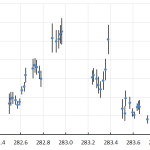A summary of the activity of the CAMS BeNeLux network during the month of May 2019 is presented. 1825 orbits were collected during 29 nights with a maximum of 84 operational cameras at 20 different CAMS stations.
1 Introduction
The first weeks of May offer nice levels of meteor activity with the eta Aquariids in the early morning hours. The last couple of weeks get shorter nights while the meteor activity decreases to the lowest level of the year. With short nights, low activity and often poor weather this time of the year remains a challenge to collect orbits.
2 May 2019 statistics
May 2019 was a reasonably good month although the first week with the Eta Aquariids activity had less luck with the weather. As many as 7 nights resulted in 100 or more orbits, not bad at all considering the limited number of dark hours at the BeNeLux latitudes this month. Only two nights remained without any orbits.
Table 1 – May 2019 compared to previous months of May.
| Year | Nights | Orbits | Stations | Max. Cams | Min. Cams | Mean Cams |
| 2012 | 5 | 13 | 4 | 2 | 2 | |
| 2013 | 13 | 69 | 9 | 13 | 6.8 | |
| 2014 | 22 | 430 | 13 | 31 | 19.7 | |
| 2015 | 25 | 484 | 15 | 42 | 24.2 | |
| 2016 | 26 | 803 | 17 | 52 | 16 | 39.9 |
| 2017 | 24 | 1627 | 19 | 64 | 22 | 52.0 |
| 2018 | 31 | 2426 | 21 | 84 | 64 | 76.6 |
| 2019 | 29 | 1825 | 20 | 84 | 53 | 72.4 |
| Total | 175 | 7677 |
The statistics for May 2019 are compared in Table 1 with all previous months of May since the start of the CAMS BeNeLux network. The maximum number of operational cameras remained stable at 84 but the number of cameras that remained operational all nights with AutoCAMS dropped from 64 in May 2018 to 53 in May 2019, also the average number of operational cameras decreased a bit. As many as 5886 of the detected meteors proved multiple station, good for 1825 orbits. This is still a very nice result although less than what the record month of May in 2018 offered with exceptional favorable weather.
A new RMS camera of the Global Meteor Network had been installed in Grapfontaine, Belgium and when all technical issues got solved, the camera got fully operational from May 15 onwards. The larger field of view combined with a much higher resolution results in 3.8 arc/pixel against 2.8 arc/pixel for an ordinary Watec camera with a 1.2/12mm lens. Pointed low to the NNW, this single camera intersects with as many as 62 other cameras at many other stations. The yield in multiple station meteors is impressive, outnumbering all other cameras except for the 003830 in Mechelen, also an RMS camera.
Since the start of CAMS BeNeLux 175 nights in May allowed to collect as many as 7677 orbits in May.

Figure 1 – Comparing May 2019 to previous months of May in the CAMS BeNeLux history. The blue bars represent the number of orbits, the red bars the maximum number of cameras running in a single night and the yellow bars the average number of cameras running per night.
Figure 1 shows the decline in average operational cameras compared to 2018. The multiple station coverage of the atmosphere was slightly worse than in 2018 due to the loss of the CAMS station at Ooltgenplaat where 8 cameras were used 7/7 with AutoCams.
3 Conclusion
May 2019 was in general a normal month of May with several clear nights, but less favorable during the Eta Aquariids activity. The exceptional month of May 2018 remains the best month of May ever.
Acknowledgment
Many thanks to all participants in the CAMS BeNeLux network for their dedicated efforts. The data on which this report is based has been taken from the CAMS website (http://cams.seti.org/FDL/index-BeNeLux.html). The CAMS BeNeLux team is operated by the following volunteers:
Hans Betlem (Leiden, Netherlands, CAMS 371, 372 and 373), Jean-Marie Biets (Wilderen, Belgium, CAMS 380, 381 and 382), Martin Breukers (Hengelo, Netherlands, CAMS 320, 321, 322, 323, 324, 325, 326 and 327, RMS 328 and 329), Bart Dessoy (Zoersel, Belgium, CAMS 397, 398, 804, 805, 806 and 888), Jean-Paul Dumoulin and Christian Walin (Grapfontaine, Belgium, CAMS 814 and 815, RMS 003814), Luc Gobin (Mechelen, Belgium, CAMS 390, 391, 807 and 808), Tioga Gulon (Nancy, France, CAMS 3900 and 3901), Robert Haas (Alphen aan de Rijn, Netherlands, CAMS 3360, 3361, 3362, 3363, 3364, 3365, 3366 and 3367), Robert Haas (Texel, Netherlands, CAMS 810, 811, 812 and 813), Robert Haas / Edwin van Dijk (Burlage, Germany, CAMS 801, 802, 821 and 822), Klaas Jobse (Oostkapelle, Netherlands, CAMS 3030, 3031, 3032, 3033, 3034, 3037, 3038 and 3039) , Carl Johannink (Gronau, Germany, CAMS 311, 312, 313, 314, 315, 316, 317 and 318), Hervé Lamy (Dourbes, Belgium, CAMS 394 and 395), Hervé Lamy (Humain Belgium,, CAMS 816), Hervé Lamy (Ukkel, Belgium, CAMS 393), Koen Miskotte (Ermelo, Netherlands, CAMS 351, 352, 353 and 354), Tim Polfliet (Gent, Belgium, CAMS 396), Steve Rau (Zillebeke, Belgium, CAMS 3850 and 3852), Paul and Adriana Roggemans (Mechelen, Belgium, CAMS 383, 384, 388, 389, 399 and 809, RMS 003830), Hans Schremmer (Niederkruechten, Germany, CAMS 803) and Erwin van Ballegoij (Heesch, Netherlands,CAMS 347 and 348).




